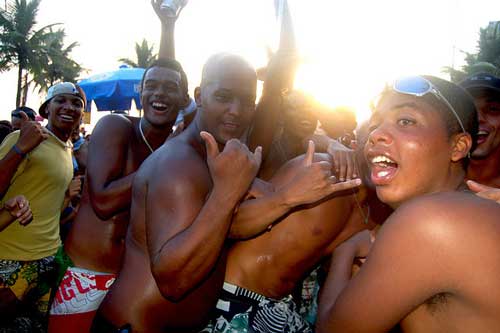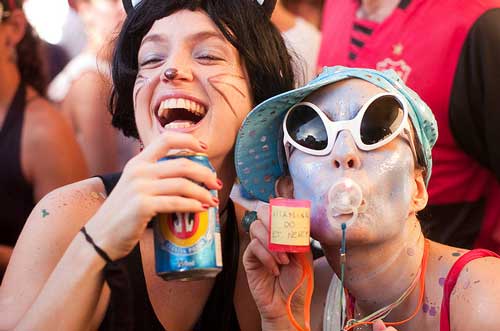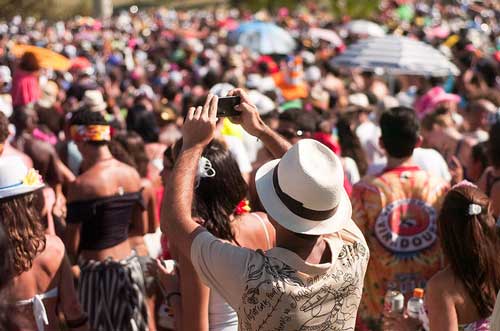
Everything is Possible: Street Carnival in Rio de Janeiro
03 February, 2011Rio de Janeiro’s carnival may be one of the most famous cultural parties in the world. However, what most people from outside Rio and Brazil may not know is that the true spirit of carnival in Rio de Janeiro is not necessarily in the official parade hosted at Sambodromo (or Sambadrome), where 12 different teams of samba schools (Escolas de Samba) compete to see who delivers the most luxurious and exciting parade. In fact, the real carnaval that the cariocas – and an increasing number of tourists – enjoy during Brazil’s holy week takes place in the streets and is completely free.
Carnival street bands, called blocos de carnaval, blocos de rua or simply blocos, are some of the names given to the street carnival bands that organise free parades in various areas of Rio. Differently from the official carnival parade at Sambodromo, in which the samba schools compete against each other, the blocos make their parade with only one simple purpose: bring free music and fun for all.
The blocos carry the genuine spirit of carnival as they play old marchinhas de carnaval, short old samba songs that have a contagious rhythm and usually have a funny content. Each bloco also composes their own theme samba song for the year, often based on recent happenings in Brazil and, again, with a very funny approach in the lyrics.
Besides all the joy provided by the music that the musicians play in the blocos, the atmosphere of each different bloco relies on the spirit of the public that attend the parade. All dressed in funny costumes – as in a fancy dress party – the cariocas go dancing and singing from bloco to bloco spreading their unique happiness through the streets of Rio.
Bloco Afroreggae (photo by Omar Uran)

The history of the blocos started in the 1960s, when Banda de Ipanema formed. Before that, Rio de Janeiro had many cordões (earlier forms of free Carnival parades in Brazil), such as Cordao do Bola Preta, one of the most traditional blocos nowadays. These cordões were composed by musicians that played classical carnival songs and Brazilian popular music. The combination of good music and free entry attracted a growing number of fans and suddenly the cordoes needed more space for their parade.
The pioneer bloco Banda de Ipanema promoted their first parade in the streets of Rio’s famous Ipanema in 1965. Being the first to launch this new exciting way of enjoying carnival, they inspired the creation of other similar bands and blocos, which also wanted to have their own space and attract the people to enjoy themselves for free.
Although the blocos experienced great success for three decades, in the 1990s the public seemed to have lost interest in joining the free parades. Disorganisation, huge crowds, and mainly the increase of violence in the streets of Rio could be pointed out as some of the main reasons for the blocos fall in popularity.
In the last five years however, it seems like the cariocas have rediscovered how to have fun in the blocos. A new generation of young cariocas have joined the idea of blocos, not only as fans but also as musicians. There are many new blocos being created everywhere by groups of friends with a common interest (neighbourhood, work place, music, etc.).
Ceu Na Terra bloco (photo by William Kitzinger)

The formation of the bands, or the carnival orchestras, is the first step to create a bloco. The orchestra is usually composed of no less than 20 musicians playing a variety of instruments such as drums, percussion, saxophones, trumpets, trombones and other Brazilian instruments like cuica and pandeiro. The bands sing both popular Brazilian music and even some international tunes with a samba approach.
As soon as the bands are formed, it’s time to “shape” the bloco. The members have to make some choices like the name of the bloco, the type of music they want to play, where they want to have the parade and what kind of target audience they are looking to play for. In addition, they usually choose a flag or a symbol, colours that represent their bloco.
Finally, the members have to register with the tourism department of Rio’s City Council then just “put the bloco in the street”. The success of the bloco and the number of people that will attend the parade depends on the word of mouth and a bit of luck for the organizers. There are some blocos that can gather up to 500,000 people. This is the beauty of the street blocos: everything is possible.
The rebirth of the blocos de carnaval has many explanations. One of the main reasons is that the official carnival of Rio is only to be watched and it only lasts for two days, whilst the street carnival is made by the people and it lasts a full week. Moreover, in the street carnival led by the blocos anyone can be part of the parade and everyone helps to make the party get even better. It is in fact the public of the street carnival that defines and decides what type and size of party each bloco will have.
Although the street blocos are the best way of enjoying Rio’s carnival, it has to be said that the official parade at Sambodromo is still a great (and expensive) event that is worth experiencing, at least once in a life time. It remains the first option for the tourists that visit Rio during carnival. And it is a mind-blowing party.
However, if you are looking to have fun like a typical carioca, get involved in the street carnival of Rio de Janeiro and enjoy the incredible atmosphere created by music and people (and lovely weather!).
Rio street party in full flow (photo by William Kitzinger)

Carnival happens in Rio every year. In 2011 the party will officially kick off on Saturday 4th of March and will last until the 8th, with the closing winners parade on the 12th. Unofficially the carnival lasts for a whole week with many street parades also from mid-February onwards. For anyone who has been planning on a trip to Rio but didn’t know the right time to go, the blocos of Rio’s street carnival are one more reason to book your flights quick!
Below, there’s a list of the most interesting blocos of Rio de Janeiro carnaval and a short description of each:
- Suvaco do Cristo (“Christ’s Armpit”, this bloco with a funny name marches just below the statue of Christ the Redeemer)
- Ceu na Terra (“Sky on Earth”, the best bloco in my opinion, a must go)
- Imprensa Que Eu Gamo (“’Press’ Me and I’ll Love You”. The ‘press’ relates to the media as this is a bloco organized by journalists)
- Carmelitas (the marching route of this traditional and extremely busy bloco goes up the hills of the beautiful neighbourhood of Santa Tereza)
- Cordão do Boitatá (this bloco is more like a ball as the band don’t march, they play for more than 10.000 people in a park in Rio’s city centre. A must go)
- Orquestra Voadora (“Flying Orchestra”, also one of the new blocos, with innovative music, a must see)
- Simpatia E Quase Amor (“Simpathy is Almost Love”, traditional bloco that marches along the beachfront avenue in Ipanema)
- Volta, Alice (“Come back, Alice”, medium size bloco in the cosy streets of Laranjeiras)
Follow Sounds and Colours: Facebook / Twitter / Instagram / Mixcloud / Soundcloud / Bandcamp
Subscribe to the Sounds and Colours Newsletter for regular updates, news and competitions bringing the best of Latin American culture direct to your Inbox.

